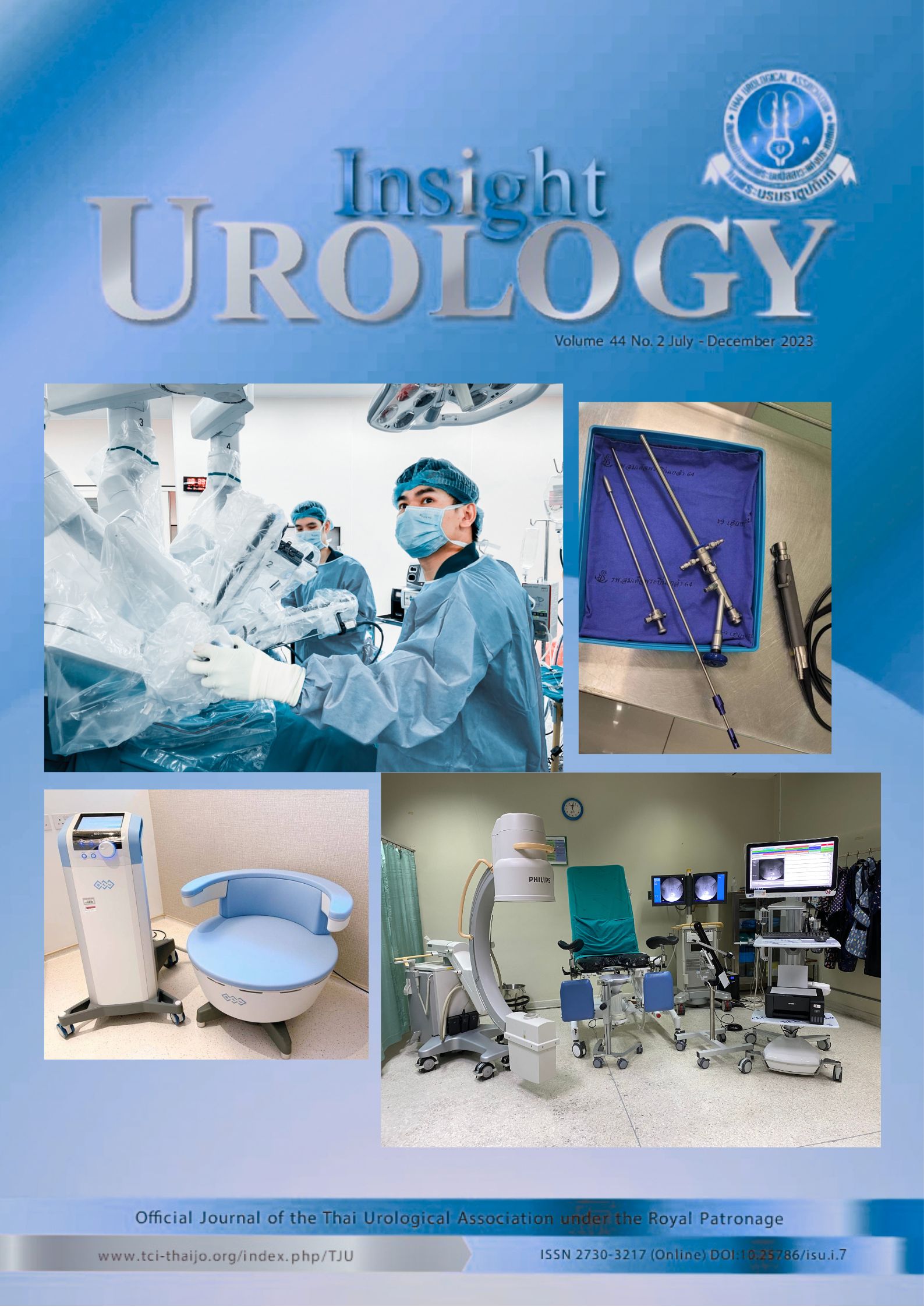Clinical outcomes of Holmium Laser Enucleation of the Prostate (HoLEP) in benign prostatic hyperplasia patients in Rajavithi Hospital
DOI:
https://doi.org/10.52786/isu.a.75Keywords:
HoLEP, holmium laser, enucleation, benign prostatic hyperplasiaAbstract
Objective: To evaluate the outcomes and safety of the surgical technique holmium laser enucleation of the prostate (HoLEP) in patients with benign prostatic hyperplasia (BPH) for whom surgeryis indicated.
Materials and Methods: The demographic characteristics, duration of surgery, blood transfusion rate, weight of tissue removed, catheterization time and complica- tions were recorded in 25 patients who underwent HoLEP surgery between January 2021 and May 2022 in Rajavithi Hospital. The International Prostate Symptom Score (IPSS), quality of life score (QoL), peak flow rate (Q-max), post-void residual urine volume (PVR), hematocrit (Hct) and prostate-specific antigen (PSA) levels were comparedbefore and after surgery.
Results: The mean age of the patients was 71.28±7.54 years. There were statistically significant differences between mean preoperative and postoperative Hct (%) (40.5± 5.9 and 38.4±5.1), p = 0.001. Only 1 in 25 patients had 1 unit of blood transfusion. One month postoperatively the mean PSA had decreased from 4.55 to 1.2 ng/ml (p < 0.001); mean IPSS had improved from 21.0 to 7.0 (p < 0.001); mean QoL score had improved from 4.47 to 1.10 (p < 0.001); mean PVR had decreased from 98.0 to 39.7 ml (p = 0.002) and the mean Q-max had increased from 8.0 to 17.8 ml/sec (p = 0.015). The mean catheterization time was 2.40±0.57 days. There were no serious complications or incidence of TUR syndrome in this study.
Conclusion: HoLEP is a safe alternative to the current gold standard transurethral resection of the prostate for BPH patients as there are fewer complications with similar functional outcomes
References
Patel ND, Parsons JK. Epidemiology and etiology of benign prostatic hyperplasia and bladder outlet obstruction. Indian J Urol 2014;30:170-6.
Kumar N, Vasudeva P, Kumar A, Singh H. Prospective randomized comparison of monopolar TURP, bipolar TURP and photoselective vaporization of the prostate in patients with benign prostatic obstruction: 36 months outcome. Low Urin Tract Symptoms 2018;10:17-20.
Gilling PJ, Cass CB, Cresswell MD, Fraundorfer MR. Holmium laser resection of the prostate: preliminary results of a new method for the treatment of benign prostatic hyperplasia. Urology 1996;47:48-51.
Chen Y-B, Chen Q, Wang Z, Peng Y-B, Ma L-M, Zheng D-C, et al. A prospective, randomized clinical trial comparing plasmakinetic resection of the pros- tate with holmium laser enucleation of the prostate based on a 2-year followup. J Urol 2013;189:217-22.
El Tayeb MM, Jacob JM, Bhojani N, Bammerlin E, Lingeman JE. Holmium laser enucleation of the prostate in patients requiring anticoagulation. J Endourol 2016;30:805-9.
Sun J, Shi A, Tong Z, Xue W. Safety and feasibility study of holmium laser enucleation of the prostate (HOLEP) on patients receiving dual antiplatelet therapy (DAPT). World J Urol 2018;36:271-6.
Riedinger CB, Fantus RJ, Matulewicz RS, Werntz RP, Rodriguez JF, Smith ND. The impact of surgical du- ration on complications after transurethral resection of the prostate: an analysis of NSQIP data. Prostate Cancer Prostatic Dis 2019;22:303-8.
Reich O, Gratzke C, Bachmann A, Seitz M, Schlen- ker B, Hermanek P, et al. Morbidity, mortality and early outcome of transurethral resection of the prostate: a prospective multicenter evaluation of 10,654 patients. J Urol 2008;180:246-9.
Gratzke C, Schlenker B, Seitz M, Karl A, Hermanek P, Lack N, et al. Complications and early postoper- ative outcome after open prostatectomy in patients with benign prostatic enlargement: results of a pro- spective multicenter study. J Urol 2007;177:1419-22.
Jhanwar A, Sinha RJ, Bansal A, Prakash G, Singh K, Singh V. Outcomes of transurethral resection and holmium laser enucleation in more than 60 g of prostate: A prospective randomized study. Urol Ann 2017;9:45-50.
Zhang Y, Yuan P, Ma D, Gao X, Wei C, Liu Z, et al. Efficacy and safety of enucleation vs. resection of prostate for treatment of benign prostatic hyperplasia: a meta-analysis of randomized controlled trials. Prostate Cancer Prostatic Dis 2019;22:493-508.
Li M, Qiu J, Hou Q, Wang D, Huang W, Hu C, et al. Endoscopic enucleation versus open prostatectomy for treating large benign prostatic hyperplasia: a meta-analysis of randomized controlled trials. PloS One. 2015;10:e0121265.
Higazy A, Tawfeek AM, Abdalla HM, Shorbagy A, MousaW,RadwanAI.Holmiumlaserenucleationof the prostate versus bipolar transurethral enucleation of the prostate in management of benign prostatic hyperplasia: A randomized controlled trial. Int J Urol 2021;28:333-8.
Kampantais S, Dimopoulos P, Tasleem A, Acher P, Gordon K, Young A. Assessing the learning curve of holmium laser enucleation of prostate (HoLEP). A systematic review. Urology 2018;120:9-22.
El-Hakim A, Elhilali M. Holmium laser enucleation of the prostate can be taught: the first learning ex- perience. BJU Int 2002;90:863-9.
Downloads
Published
How to Cite
Issue
Section
License
Copyright (c) 2023 Insight Urology

This work is licensed under a Creative Commons Attribution-NonCommercial-NoDerivatives 4.0 International License.



